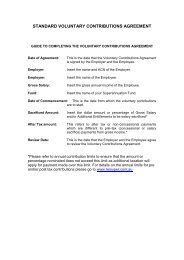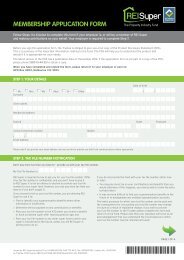Member Information Booklet - REI Super
Member Information Booklet - REI Super
Member Information Booklet - REI Super
You also want an ePaper? Increase the reach of your titles
YUMPU automatically turns print PDFs into web optimized ePapers that Google loves.
example of annual fees and costs for<br />
a balanced investment option **<br />
This table provides an example of how the fees and costs<br />
in <strong>REI</strong> <strong>Super</strong>’s Trustee <strong>Super</strong> Balanced Option can affect your<br />
superannuation investment over a one-year period. You can<br />
use this table to compare this investment option with other<br />
superannuation products.<br />
example – the trustee <strong>Super</strong> balanced<br />
investment option<br />
balance of $50,000<br />
with total contributions of $5,000 during year<br />
Contribution fees Nil For every $5,000 you put in, you will be charged $0.<br />
Plus<br />
Management costs<br />
equals<br />
Cost of fund<br />
From 0.68% to 0.75% +<br />
$85.80 ($1.65 per week)<br />
For every $50,000 you have in the Fund you will be charged between $340 and<br />
$375 each year, plus $85.80 in administration fees, regardless of your balance.<br />
If you put in $5,000 during a year and your balance was $50,000, then for that<br />
year you will be charged fees of between $425.80 and $460.80.*<br />
What it costs you will depend on the investment option you choose and the fees<br />
you negotiate with your fund and financial adviser.**<br />
* Additional fees may apply:<br />
If you leave the Fund, you will also be charged a Withdrawal fee of $90.<br />
Buy/Sell spreads may apply to some investment options. See ‘Buy/Sell spreads’ below and the preceding Investment section for details.<br />
** This is a standard format example required by Australian law. The term ‘Balanced Investment Option’ refers, in <strong>REI</strong> <strong>Super</strong>’s case, to the Trustee <strong>Super</strong> Balanced<br />
Option. <strong>REI</strong> <strong>Super</strong> does not pay commissions to advisers. As an industry fund that returns all profits and costs to members’ accounts, it provides the same fees for all<br />
members and does not allow negotiation on fees.<br />
buy/Sell spreads<br />
The Buy/Sell spreads for the Fund’s investment options are:<br />
<strong>Super</strong> growth 0.50% (50 basis points)<br />
trustee <strong>Super</strong> balanced 0.40% (40 basis points)<br />
<strong>Super</strong> Stable 0.22% (22 basis points)<br />
<strong>Super</strong> Cash Zero (0 basis points)<br />
Australian Shares 0.60% (60 basis points)<br />
international Shares 0.50% (50 basis points)<br />
Australian Property 0.40% (40 basis points)<br />
global Property 0.70% (70 basis points)<br />
fixed interest Zero (0 basis points)<br />
When a contribution is received or a benefit is paid, it is used<br />
to purchase or sell units in your investment option. For some<br />
investment options, the entry price for the issue of units may be<br />
different from the exit price for the redemption of those units.<br />
The difference between the entry and exit price represents<br />
an allowance for transaction and operational costs, and is<br />
commonly referred to as a ‘Buy/Sell spread’. This Buy/Sell<br />
spread is paid to the external investment managers, and simply<br />
reflects the cost associated with the investment transaction.<br />
Buy/Sell spreads (if incurred) are additional costs and do not<br />
form part of the management costs shown in the ‘Example of<br />
annual fees and costs’ table above. They are included in the<br />
unit-pricing process.<br />
The Fund will, wherever possible, use available cash flow (e.g.<br />
contributions coming in) to pay benefits to members leaving the<br />
Fund. This will avoid costs associated with buying and selling<br />
underlying assets. Any saving produced is distributed to members<br />
of the Fund as part of the calculation of unit prices. This results in<br />
a reduction in the management costs charged to members. See<br />
above for the Buy/Sell cost for each investment option.<br />
page 21<br />
Additional explanation<br />
of fees and costs<br />
investment management costs<br />
The percentage-based investment management costs shown<br />
in the tables above and opposite are estimates and will vary<br />
from year to year, reflecting actual expenses incurred, the value<br />
of assets invested with each investment manager, and whether<br />
performance based investment fees apply.<br />
If the actual expenses incurred are greater than the estimate,<br />
then the unit price would decrease. If the actual expenses<br />
incurred are less than the estimate, the unit price would<br />
increase.<br />
Performance-based investment fees charged by some<br />
managers are deducted from the portion of the Fund’s assets<br />
invested in the underlying portfolio they manage, and are<br />
reflected in the unit prices of the Fund. Performance fees are<br />
typically between 10% and 20% of performance above a relative<br />
benchmark index.<br />
The estimated performance-based fees shown assume that:<br />
the current strategic asset allocation to existing investment<br />
managers with performance-based fees remains unchanged; a<br />
performance fee of 10.25% applies; and a performance outcome<br />
of 10% above the benchmark is achieved.<br />
This is considered a conservative estimate that could be payable<br />
in a year. However, they could be higher or lower, depending on<br />
the actual performance outcome achieved by each manager.





